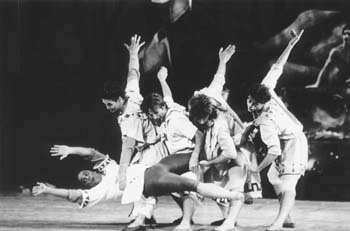![[Metroactive Stage]](/stage/gifs/stage468.gif)
[ Stage Index | San Jose | Metroactive Central | Archives ]
 Swing Fever: Comedic movement marked the dances of 'A Midsummer Night's Dream.' Enchanted 'Night' San Jose Cleveland Ballet scatters choreographic fairy dust in 'A Midsummer Night's Dream' By Scott MacClelland IF YOU MISSED the enchantment, you'll have to chase it all the way to Cleveland. That's where Dennis Nahat's A Midsummer Night's Dream will reprise its magic over two weekends, starting Oct. 29. However, if you attended one of the six performances last weekend at San Jose Center for the Performing Arts, you got enough fairy dust to adjust your attitude right up till now. While the San Jose Cleveland Ballet's ambitious production displayed uneven standards of refinement among its principals, it saved the most important roles for its best dancers, those who went beyond choreography into personal characterization. Not surprisingly, the inspired moments occurred in the dream world of fairy king Oberon and his queen Titania, rather than in the formalized court of the Athenian Duke Theseus and his consort, the Amazon queen Hippolyta. Set to a melange of Mendelssohn's music, including the familiar Midsummer overture and incidental music--plus movements of symphonies, various obscure overtures and some chamber music--the scenario begins with the conquest of the Amazon women by the soldiers of Athens. Here, and in the final Athenian scene, Nahat constructed his designs primarily from classical syntax and vocabulary. But once within the dream itself, the choreography became far more eclectic, individualistic and narrative. With five dozen dancers, and characters almost too numerous to track, small wonder that Nahat's desire to communicate the story clearly focused on a few key figures, chief among them the astonishing Raymond Rodriquez, who gave the mischievous Puck the most athletic, comedic and expressive range of all. While Puck is the star, others within the dream exhibited distinctive personal flair and/or unusual artistic integrity, including Grethel Domingo (Helena), Udval Bat-Erende (Oberon), Karen Gabay (Titania), Gonzalo Espinoza (Bottom), Leo Zen (Demetrius), Olivier Muñoz (Lysander) and the coolly aloof Nancy Latoszewski (Hermia). Laughs attended the comedic shtick indulged by many of the above, plus the recurrent parade of "craftsmen" trying to escape their ass-headed colleague Bottom. Traditional balletic values interrupted the narrative with solos that indulged display without really enhancing character. The corps punctuated moments of the dream with both dramatic and ritualistic passages, made more charming by the inclusion of a troupe of well-trained youngsters from the company's ballet school. The formalized scenes at the court of Theseus paid the biggest tribute to the classical models but also focused more attention on the vagaries of skill within the company. Peter Kozak (Theseus) was heavy in his technique and lacked subtlety. Various members of the corps who had appeared in character roles (Greek soldiers, Amazon warriors) were unrefined within the disciplines of line and precision, extension and turnout. Maydee Pena (Hippolyta) embodied imperious aloofness. Dwight Oltman's orchestra (now individually contracted, not "rented" as before from the San Jose Symphony) gave opening night a few rough entrances but a vivid presence. A small chorus of women's voices produced a surprisingly big sound from the pit. Delicious, stage-filling scenery and often-whimsical costumes by David Guthrie, enhanced by the lighting of Dean Moye, did an superb job of making Shakespeare's fantasy last as long as possible even while it ended too soon. [ San Jose | Metroactive Central | Archives ]
|
From the October 21-27, 1999 issue of Metro, Silicon Valley's Weekly Newspaper.
Copyright © 1999 Metro Publishing Inc. Metroactive is affiliated with the Boulevards Network.
For more information about the San Jose/Silicon Valley area, visit sanjose.com.